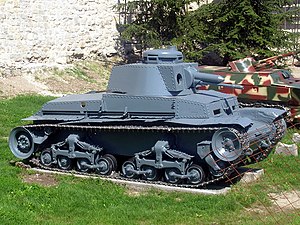LT vz. 35
| Panzerkampfwagen 35(t) | |
|---|---|

Panzer 35(t) at the Belgrade Military Museum.
|
|
| Type | Light tank |
| Place of origin | Czechoslovakia |
| Service history | |
| In service | 1936–50? |
| Used by | |
| Wars | World War II |
| Production history | |
| Designer | Škoda |
| Designed | 1934–36 |
| Manufacturer | Škoda, ČKD |
| Unit cost | 741,868 or 745,068 Czechoslovak koruna |
| Produced | 1936–40 |
| No. built | 434 |
| Variants | T-11, TACAM R-2 |
| Specifications (Panzerkampfwagen 35(t)) | |
| Weight | 10.5 t (10.3 long tons; 11.6 short tons) |
| Length | 4.90 m (16 ft 1 in) |
| Width | 2.06 m (6 ft 9 in) |
| Height | 2.37 m (7 ft 9 in) |
| Crew | 4 (3 in original design) |
|
|
|
|
Main
armament |
3.7 cm (1.5 in) KwK 34(t) gun |
|
Secondary
armament |
2 x 7.92 mm (0.3 in) MG 37(t) machine gun |
| Engine | 4-cylinder, water-cooled Škoda T11/0 gasoline 120 hp (89 kW) |
| Power/weight | 11 hp/tonne |
| Transmission | 6 x 6 |
| Suspension | leaf spring |
| Fuel capacity | 153 l (40 US gal) |
|
Operational
range |
120 km (75 mi) or 190 km (120 mi) |
| Speed | 34 km/h (21 mph) |
The Panzerkampfwagen 35(t), commonly shortened to Panzer 35(t) or abbreviated as Pz.Kpfw. 35(t), was a Czechoslovak-designed light tank used mainly by Nazi Germany during World War II. The letter (t) stood for tschechisch (German: "Czech"). In Czechoslovak service, it had the formal designation Lehký tank vzor 35 (Light Tank Model 35), but was commonly referred to as the LT vz. 35 or LT-35.
A total of 434 were built; of these, the Germans seized 244 when they occupied Bohemia-Moravia in March 1939 and the Slovaks acquired 52 when they declared independence from Czechoslovakia at the same time. Others were exported to Bulgaria and Romania. In German service, it saw combat during the early years of World War II, notably the Invasion of Poland, the Battle of France and the invasion of the Soviet Union before being retired or sold off in 1942. It was used for the remainder of the war by other countries and as a training tank in Bulgaria into the 1950s.
The Panzerkampfwagen 35(t) was assembled from a framework of steel "angle iron" beams to which the armour plates were riveted. A 4 mm (0.16 in) firewall separated the engine compartment from the crew. It had several mesh-covered openings to allow access to the engine and improve ventilation by drawing air in through the commander's hatch. This had the advantage of rapidly dispersing gun combustion gases when firing, but several disadvantages. The constant draft generated by the engine greatly affected the crew during cold weather, the danger of an engine fire reaching the crew compartment was increased and the engine noise and heat increased crew fatigue.
The driver sat on the right side of the tank using a 390 by 90 millimetres (15.4 in × 3.5 in) observation port protected by 50 millimetres (2.0 in) of bulletproof glass and an armoured shutter 28 millimetres (1.1 in) thick. To his right was a vision slit 120 by 3 millimetres (4.72 in × 0.12 in) with a similar thickness of bulletproof glass. The Germans replaced the original three colored lights used by the Czechs to communicate with the driver with an intercom system. The radio operator sat on the left and had his own 150 by 75 millimetres (5.9 in × 3.0 in) observation port with the same protection as the driver's. His radios were mounted on the left wall of the hull. The hull machine gun was between the driver and radio operator in a ball mount capable of 30° of traverse, 25° of elevation and depressing up to 10°. Most of the machine gun's barrel protruded from the mount and was protected by an armoured trough. The mount had a spotting telescope, but open sights could be used if the plug at the top of the ball mount was removed. If necessary, the driver could lock the mount into position and fire it himself using a Bowden cable. The driver's hatch was exposed to direct fire and could be damaged from the front.
...
Wikipedia
